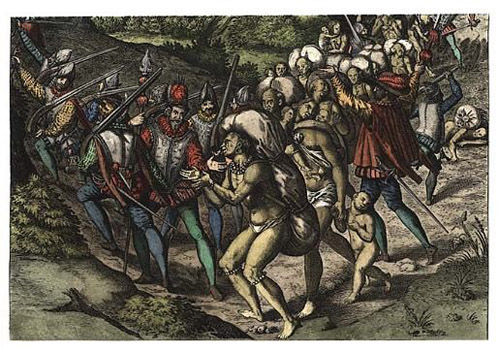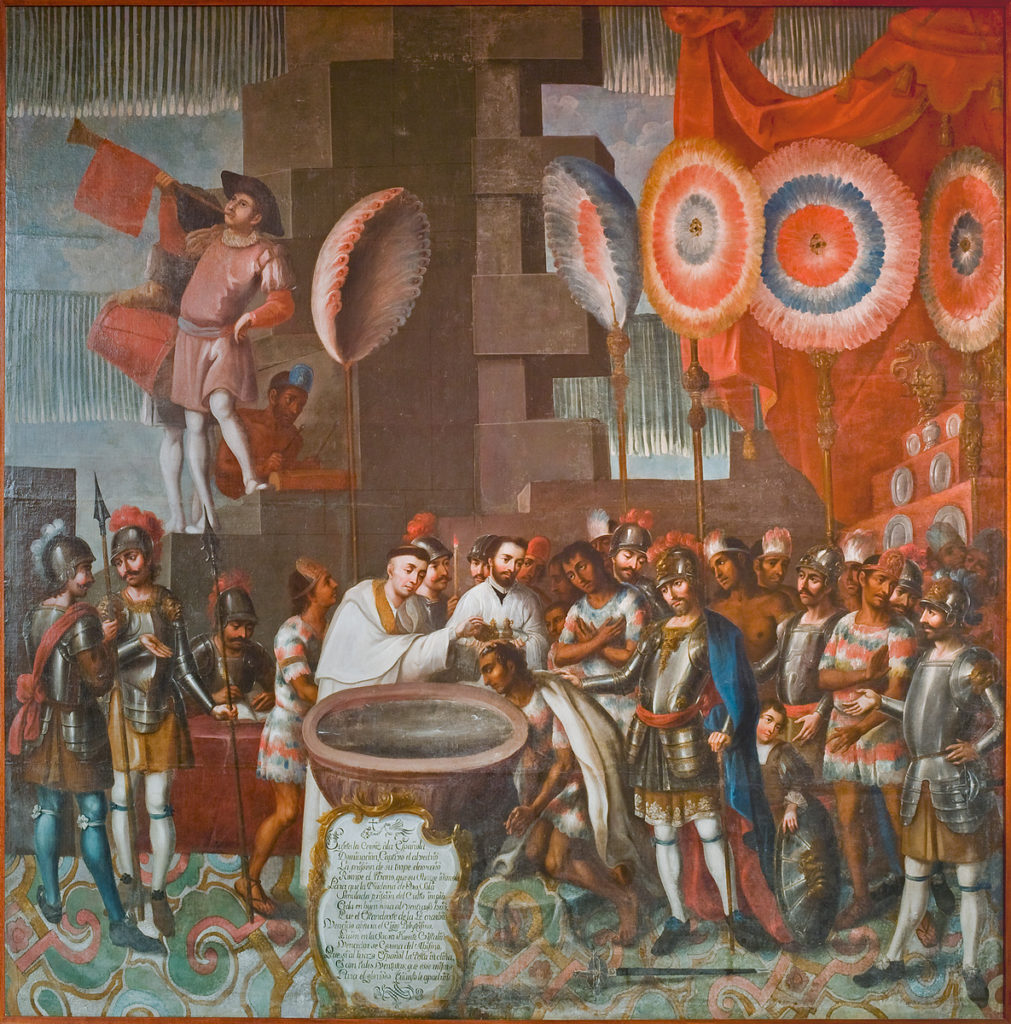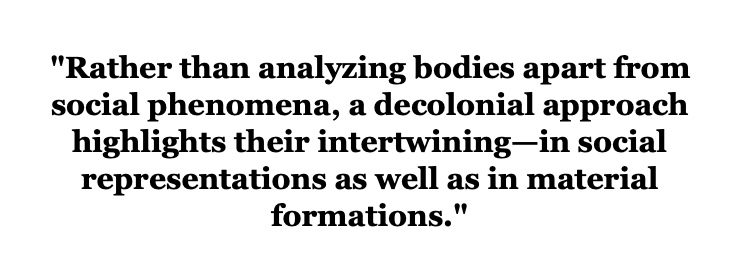
The body is central to religious life. Religious practices and teachings include insights about food, cleanliness, ritual, sex, and death. But scholarship in the study of religion has at times been oddly forgetful of the embodied grounds of religious traditions and of knowledge. This occlusion of the constitutive role of bodies and materiality is recognized as part of the legacy of modernity. Modern thought construed abstract reason as more reliable than sensibility and imagined rationality as exercising control over one’s body and non-human materiality. But these well-known elements of modern thought are intricately related to colonialism and its organization of the world.
Decolonial scholarship on the body entails not just adding a new category of analysis; it requires a shift in approach. Rather than treating religion, coloniality, and the body as self-contained or self-evident categories, we analyze their imbrication in particular contexts and the ways such terms evoke each other, even where their relationship is forgotten or hidden. In this very short essay, I point to two temporally distant, but paradigmatic examples of the intertwining of religion, bodies, and coloniality. I travel imaginatively to a point of entanglement, as Édouard Glissant suggests, in order to surface connections.
Postcolonial studies in the US academy has tended to start in the eighteenth century, while decolonial studies attends to the earlier period of the Spanish and Portuguese empires. As a consequence, decolonial studies make visible connections between coloniality and religion that are less explicit in scholarship of the later empires. Religious identities were a defining element in the formation of the Spanish empire. Walter Mignolo observes, for instance, “Christianity established itself as intolerant to Judaism and Islam as well as to the ‘idolatry’ of the Amerindians, whose extirpation became a major goal of the church in the sixteenth and seventeenth centuries” (21). The relationship to Jews and Moors shapes later Spanish discursive and material practices toward the Amerindians.

The distinctions between Christians, Jews, and Moors were based on well-established categories of religious identity, and they were represented as corporeal and inherited differences. As David Nirenberg has argued, categories of religion “were replaced by the genealogical notion that Christians descended from Jewish converts (Cristianos nuevos, confessos, conversos, marranos) who were essentially different from Christians by nature” (242, italics mine). Indeed, according to the doctrine of “limpieza de raza,” “Jewish and Muslim blood was inferior to Christian; the possession of any amount of such blood made one liable to heresy and moral corruption; and therefore any descendent of Jews and Muslims, no matter how distant, should be barred from churches and secular office, from any guilds and professions, and especially from marrying Old Christians” (242). (“Old Christians” referred to those born of Christian parents.) Predicting moral character based on inheritance and managing the risk of contamination through the control of sexual relationships are today associated with “biological race.” But in 14th to 15th century Spain, religious identity was similarly woven through the body to naturalize socio-political hierarchy. This mobilization of bodily discourse in describing religious difference was transposed to the Americas, though not unchanged.
In the Americas, the term “Moor” was used for anyone of dark skin, making skin color a metonymy for a myriad of markers of religious difference. The subordination of Amerindians was asserted through arguments about their religion, practices, and embodiment. The tensions between the bodily and cultural frames for perceived inferiority are evident in the well-known debates of Valladolid between Juan Ginés Sepúlveda and Bartolomé de las Casas (1550-51). The issue at stake was the right of the king of Castile to subjugate the Amerindians. But the significance of the debate is that the arguments revolved around the status of Indians as human beings, which was treated as an inquiry into their rationality. Sepúlveda, a humanist and translator of Aristotle, based his defense of the conquest on Aristotle’s theory of “natural slavery” as well as on Augustine’s argument that slavery is a punishment for sin (112f). [1] His position was that the Indians were slaves by nature, displaying “an innate weakness of mind and inhuman and barbarous customs” (115). They are as different to the Spaniards as “monkeys are to men,” he claimed (117). In contrast, Las Casas challenged the applicability of the category of “natural slave” to the peoples of the Americas. He explained his position by appealing to cultural evolution. Turning to classical writers like Aristotle and Cicero, in addition to Thomas Aquinas, Las Casas argued: “All the races of the world are men, and the definition of all men and of each of them, is only one and that is reason” (140). If their behavior was starkly different, even seemingly abhorrent, it was not because of an inherent flaw in their capacity for rationality. The differences in the behavior of Amerindians, he argued, was the effect of their primitive culture and religion. The behavior in question included quotidian embodied practices concerning food, the use of the land, and sex. Christianity was deemed necessary to transform these barbarians into civilized men. The Spaniards had the duty to teach the Amerindians as children until they achieved the level of civility of European Christians.

Bodily practices were mined for evidence of humanity or lack thereof. Bodies were also the site of religious/colonial intervention, the entry-point for the transformations of those subjected to colonial/religious power. Souls would be conquered through the imposition of specific forms of labor, diet, ritual, sexuality, and family. María Lugones highlights the implications of coloniality for gender by showing that colonialism entailed imposition of distinct gender systems for colonizer and colonized. Native gender identities and familiar arrangements were regarded as “unnatural.” Colonialism broke the links between communities, the land, and their ancestors. Colonialism dismissed and destroyed forms of embodied existence to impose others forms of being that it represented as “natural” and thus universal.
The problematic role of the body in these formative moments of coloniality might tempt us to veer away from theorizations of the body altogether. Indeed, I wonder if the attention to the scrutiny and debasement of colonialized bodies bolsters the appeal of the fantasy of disembodied subjectivity. After all, Christianity defined its universalism against the Jews, represented as too corporeal. The more racialized others are associated with corporeality, the more normalized an ideal disembodied subject becomes. A decolonial philosophy of religion includes the critical insights from other scholarly critiques concerning the occlusion of bodies and materiality, while also tracing the relationship between disembodied universalisms and the projection of debased materiality onto colonized and racialized others.
I have found Maurice Merleau-Ponty’s theorization of flesh productive in its attention to the ways in which bodies, all bodies, are shaped by the materiality of the world. He attempts to think beyond the Cartesian suspicion of the senses and beyond the separation of the subject from the body. Neither bodies nor materiality are static; both shape and are shaped by human action, including ideas and imagination. Inasmuch as ideas and imagination orient human action they transform the world. And the world in turn shapes our bodies. But even as Merleau-Ponty imagined a world in which all human beings belong to the world, where we all reach toward the world and are received by the world, he lost sight of the ways in which coloniality has transformed the world. He lost sight of how encountering the world meant something starkly different for Hernán Cortez and for the Amerindian subjected to the Spanish crown and its mission. We are all constituted by our relations to the materiality of the world, as Merleau-Ponty beautifully describes, but we inhabit it differently.

Frantz Fanon articulates this critique by focusing on inter-human encounters. He dramatizes how his move toward the world is met with the violent gaze of those whose perception has been distorted by coloniality. Their reactions to Fanon’s body interrupted his approach and impeded the constitution of his body in relation to the world. His body was thus shattered. Sylvia Wynter builds on Fanon’s insights to propose a reconceptualization of the human as a nexus of bios and logos, that is, as constituted by culture and religion as much as by biology. This allows us to analyze how representations of religious differences appeal to embodied differences, or how bodily differences shape the representations of the religious practices of a particular group. It can also help us track how those representations in turn shape the lives of those affected by them—where we can live or work, what we can eat, who we can embrace—and through all of these patterns shape our bodies. A decolonial approach to religious studies might also help us imagine differently toward the transformations of our bodies and the world.
[1] Citations here and in remainder of paragraph to Anthony Pagden, The Fall of the Natural Man: The American Indian and the Origins of Comparative Ethnology (Cambridge: Cambridge University Press, 1982).

